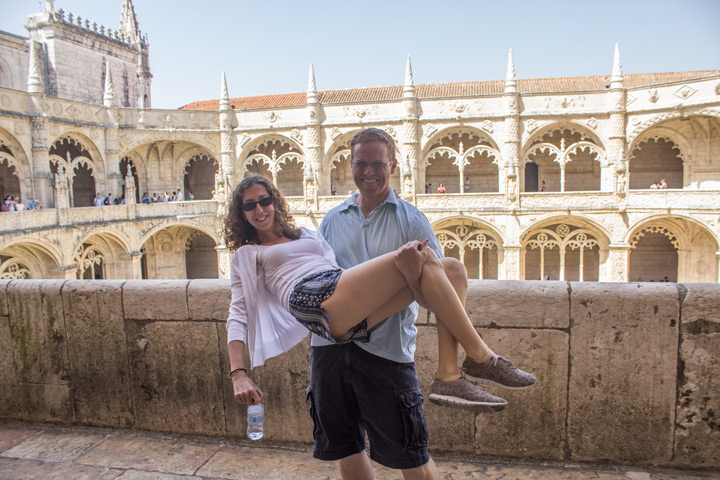Chris & Allyson vs. Europe (2017)
Portugal Day Two: Belem. Mosteiro dos Jeronimos. Monument to the Discoveries. Tower of Belem. Maritime Museum. Tropical Botanical Garden. Alfama at night.
Lisbon has seen its share of disasters, and it narrowly avoided a new one on the second day of our visit. We woke up with no luggage and only sweat-stained clothes to wear. It was shaping up to be an exceedingly smelly day.
We talked it over during breakfast. [Our standard hotel breakfast routine: I get a bowl of cereal and eat the whole thing before Allyson even finishes choosing what she wants to eat. Then I watch her eat for an agonizingly long time.] We could go buy more clothes at El Corte Ingles. We could make peace with our situation and just smell bad to everyone around us. We could fake French accents all day, so America's reputation wouldn't take the hit.
It was all rendered moot, for when we returned to our room after breakfast, our bags were waiting. It's nice to see castles, and cathedrals, and exotic countrysides. But it's thrilling to put on clean clothes after two days without them. Take a vacation from hygiene. It makes you appreciate home.
We were finally ready to turn to the business of the day: The Age of Discovery. Modern Portugal is a smallish country with little sway in global affairs. But 16th century Portugal was an empire with godlike influence over the global supply of seasoning. If you wanted pepper, you had to deal with Portugal. That's power.
I love maritime history. My dad was in the Navy, and I have always loved books and movies about the sea. Learning about maritime history is a great way to share in the invigorating exploration of the unknown, without having to be uncomfortable for even a second. Before we left for Portugal, I warned Allyson that we'd be indulging my nautical jones for at least half a day. Because she's a great wife, she resigned herself to her horrible fate.
The place to experience Portugal's amazing seafaring history is Belem. Removed from "downtown" Lisbon, it's a neighborhood that commands the mouth of the Tagus. Great voyages of discovery and commerce started in Belem; tremendous wealth poured into Portugal through Belem. When Portugal was at its most interesting, Belem was at the center.
Today, Belem is often at the center of cruise ship excursions, so we hopped in a cab and got there relatively early, to beat the crowds. The first stop: the Mosteiro dos Jeronimos.
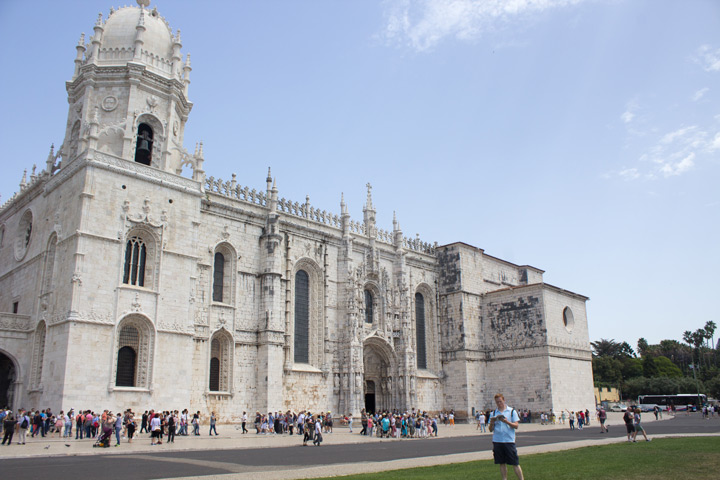
Starting our morning at Mosteiro dos Jeronimos.

A cloister inside the ridiculously ornamented Manueline monastery.

Posers gotta pos. Mosteiro dos Jeronimos.

The cathedral, a vaulted and ornate showroom for Jesus.
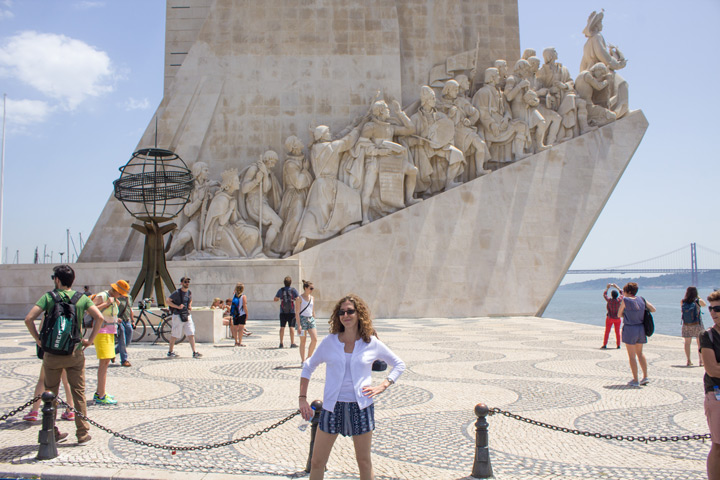
On the Belem waterfront, a monument to Portugal's maritime glory.

The tower of Belem, a prison, fort, customs house and tourist destination.
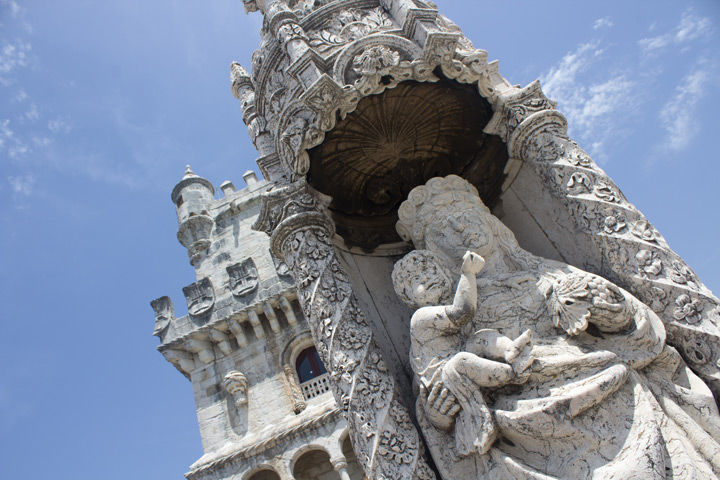
Ornamentation inside the tower of Belem. You can't have a fort without religious statues.
First, some context. Portugal had all of its greatest hits in the late 15th and early 16th centuries, when explorers laid claim to a bunch of new colonies and established the first oceanic routes between Asia and Europe. With the jump on the rest of Europe, Portugal dominated overseas trade for many decades -- and the big money was in spices, an exotic cargo you couldn't get at home. Before the Age of Discovery, the kings of Portugal were soaking up their wealth from one tiny corner of the map. Suddenly they were deluged with insane amounts of money from around the world.
Insane amounts of money are only good if you spend insanely, so the Portuguese monarchs went nuts. The country was festooned with palaces, monuments and estates. The kings also ordered up ridiculous cathedrals and monasteries, because there's nothing better than showing off your wealth while also getting credit for being a good Catholic.
Near the start of the 16th Century, King Manuel decided to give a major upgrade to the Mosteiro dos Jeronimos, probably with the thought that he would one day be buried there. (Who doesn't want a nice place to sleep?) After a century or so of construction, the masterpiece was finished. The monastery features a kick-ass cathedral and an enormous dwelling place for monks. The architecture is now known as "Manueline." It involves a lot of ornate stonework, a lot of which has vaguely nautical motifs. (For example, intertwined ropes.) In the Manueline style, everyone colored to the edge of the page; the ceilings are beautifully vaulted, and every column is delicately carved. The whole thing was made possible by "pepper money" -- the enormous wealth created by the spice trade.
Cruise companies dump people at the monastery so they can walk through the cathedral; it creates a big logjam at the entrance. But we were there for the full experience, so we skirted the crowd and started with the actual monastery. The cloister was beautiful, with all kinds of nature motifs and mythical animals carved into the stone. This allowed monks to stare at freaky art while contemplating god's greatness.
By the time we were done with the contemplative side of the building, the crowds at the cathedral had thinned out a little. So we jumped over to the "LOOK AT HOW AWESOME GOD IS" side. It's impressive, and it features the tombs of a bunch of royals. For a few extra bucks, we checked out the sacristy. But the highlight (for me, at least) was the final resting place of Vasco da Gama. He was the first guy to find that oceanic route to Asia. He kicked off the Age of Discovery, making the monastery possible. The kings had the power, but American school kids learn only about Vasco da Gama. He is, indisputably, the most famous Vasco of all time.
Amazingly enough, Belem had even more to offer. When we were done with the monastery, we hoofed the short distance to the Monument to the Discoveries. As you may recall from the chronicle of the day before, Portugal had a dictator for a significant chunk of the 20th century. And while he had many bad qualities, he did have a flair for the dramatic. In 1960, he oversaw the creation of the monument, a big stone thingy on the bank of the Tagus.
A lot of times, nationalist monuments are giant stone piles of crap, but the Monument to the Discoveries has some flair. It was put up to honor the stars of the late 15th and early 16th centuries, when Portugal was the sexiest seafaring nation. The overall structure is shaped like a caravel, the workhorse of the Portuguese fleet. There are a number of historic and symbolic figures caved into the structure, and at the "prow" is Prince Henry the Navigator -- considered by many to be the most significant patron of the seafaring arts.
The monument is striking, and it sits on a plaza decorated with a world map highlighting the Age of Discovery. The majesty was slightly diminished by a small army of aggressive hucksters trying to sell selfie sticks to tourists every five seconds. In 2017, this was apparently a viable business model. Middle-aged men would walk the waterfront and hard-target anyone looking slightly foreign. Market forces clearly showed that tons of tourists on the Belem waterfront were lacking selfie sticks, and Portuguese losers rushed in to satisfy that need. We were literally followed for a third of a mile by one salesman as we walked the waterfront. But on the positive side, it gave us something to talk about on our way to the Tower of Belem!
And what is the Tower of Belem? It's another artifact of the 16th century. Thanks to the Age of Discovery, Portugal was pulling in a lot of wealth. It occurred to the Portuguese that outsiders might try to take all that wealth, by sailing straight up the Tagus and bombarding the living s*** out of Lisbon. So they built some forts to secure the river.
The tower is probably the coolest of those forts. For reasons I cannot quite understand, it is situated a stone's throw from the banks of the Tagus -- far enough from the shore to be inconvenient, but not far enough away to grant a major strategic advantage. It's a picturesque white stone structure, with a handful of Manueline design elements. And it's tiny enough that they can't take more than a hundred visitors at a time.
Fortunately, we bought our tickets in advance. (It was a package deal with the tickets to the monastery.) So we skipped the ugly looking line and soon found ourselves in the tower. It's a neat space! From a military perspective, it was probably outdated the day it was completed. There are cannon ports in the building, but the tower is so tiny that it probably didn't have enough firepower to do much good. Fortunately for Portugal, the tower was never tested -- and the structure was adapted to serve as a prison and a customs house. And since it was never attacked, the tower's 16th-century charm is more or less unspoiled. We had real fun squeezing through the ridiculously narrow passageways; we had ironic fun waiting on the spiral staircases for five minutes until the traffic allowed us to pass. Considering that nothing really important ever happened there, the Tower of Belem is wildly popular.
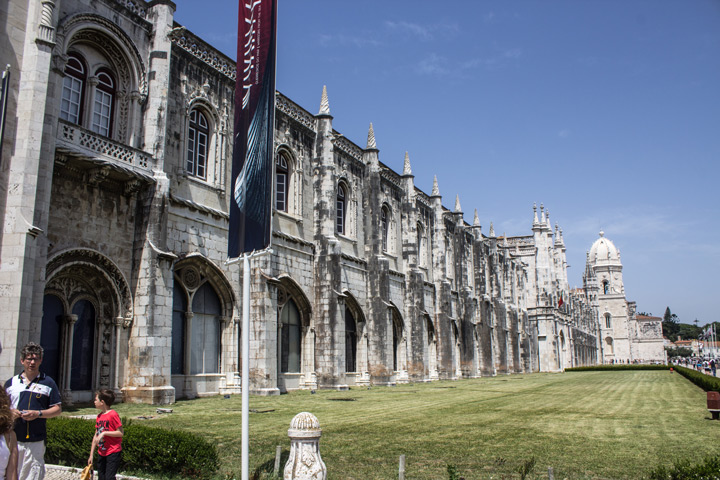
Back to the monastery complex, for a stroll through the maritime museum.

Some models and artifacts from when Portugal ruled the high seas.
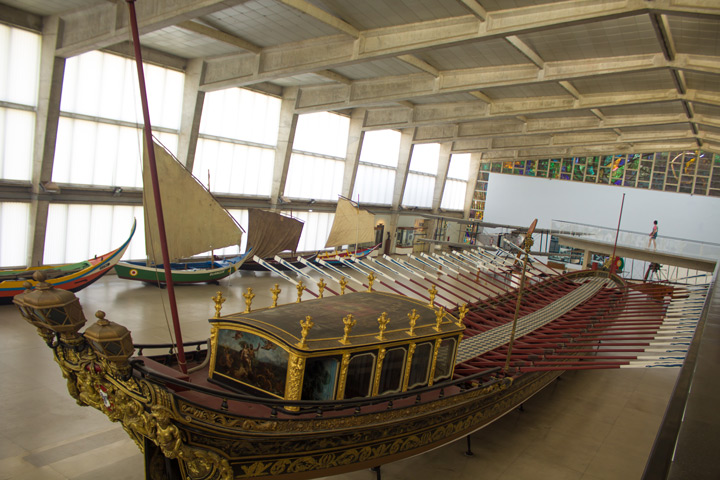
A crown jewel of the royal barge collection, at the martime museum.
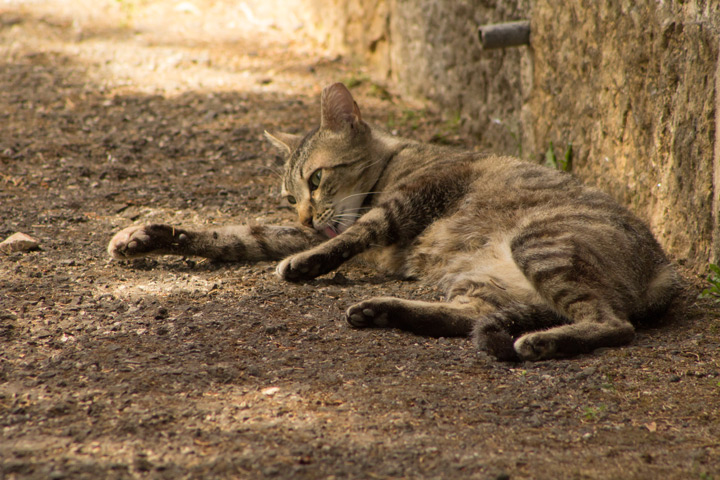
At the Tropical Botanical Garden, a feline friend relaxes.

The birds at the Tropical Botanical Garden weren't exactly pretty.

Back to Alfama for dinner, and to get the nighttime vibe.
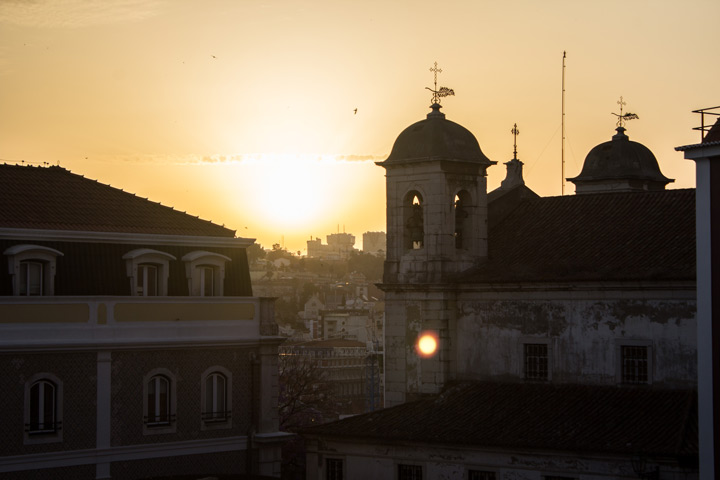
Sunset over Lisbon, seen from the hill of Alfama.

A jazz trio plays to passersby, and the sound echoes through Alfama's alleys.
After a long lunch at a restaurant along the Tagus, we found ourselves back at the monastery. One wing of that structure has been turned into Portugal's maritime museum, and I decided to use all my Chris cards in one day. We spent an hour looking at ship models, reading about the spice trade, and checking out a very impressive collection of royal barges. (The most "modern" barge was used when Queen Elizabeth II visited Portugal in 1957. It's gotta feel good to have 80 sweaty Portuguese dudes rowing on your behalf while you sit in the back and wave at people.) We closed our afternoon with a stroll through the nearby Tropical Botanical Garden. Back in the day, it was an educational facility for those hoping to learn how to cultivate plants from the far-flung reaches of the Portuguese empire. Today, it's a sleepy park with a nice smattering of birds. It wasn't quite exciting, but for two euros it wasn't so bad.
We strolled the main drag in Belem, but there wasn't much more to see -- shortly after, we took another cab back to the hotel. For the evening, Allyson had the notion that the alleys of Alfama might be neat to see at night. It didn't pan out quite as we hoped, because the lights weren't particularly grand. But we had a nice enough dinner at a restaurant overlooking the city. And on the way home, we stumbled across a jazz trio of street musicians. The acoustics of Alfama are delightful, and as we walked home we could hear their songs echoing through all the streets below. It was very European, even though jazz is the most American art there is.
Lisbon was pretty much behind us. All we had left to explore was the rest of the country. No problem, right?
